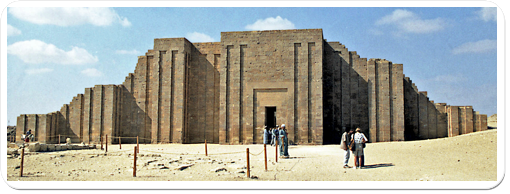The Early Dynastic Period is a period at the start of what is conventionally considered the history of Ancient Egypt. It was the culmination of the formative stage of the Ancient Egyptian culture that began centuries before during the Prehistory.
The typical artistic canon for two-dimensional representations is already obvious in the Narmer Palette.
It was during this period that the divine kingship became well established as Egypt's form of government, and with it, an entire culture that would remain virtually unchanged for the next 3000 years.
Writing evolved from a few simple signs mainly used to denote quantities of substances and their provenance, to a complex system of several hundreds of signs with both phonetic and ideographic values fit for administrative, political, religious as well as literary purposes.
The typical ancient Egyptian artistic canon took shape for both two and three dimensional representations, determining the work of artists for millennia to come.
Another very important change that marks the beginning of the Early Dynastic Period is the rise of urbanism. Inhabitants of small settlements throughout the country abandoned their homes and moved to larger communities and cities. Several key factors, that could vary from region to region, have influenced this process of urbanisation:
- The need for security may have caused people to seek protection within the safety of fortified walls.
- It facilitated central control of the population by the state. Some relocations may thus have been forced by the government. The process of urbanisation appears to have started earlier in societies with a stronger hierarchical structure.
- Changes in the natural environment. This has apparently been the case at Hierakonpolis, one of the most important cities in late Predynastic Egypt.
- Society was evolving beyond its mere agricultural needs and required specialised craftsmen, traders and other skilled personnel. The ruling elite needed these people not only to be close at hand, but also to work and thus live together.
- Demographic changes, such as a growth in population, may have caused smaller settlements to extend and merge into one larger community.
As the Early Dynastic Period is the culmination of an on-going cultural, religious and political evolution, it is hard to determine its actual beginning. According to the Ancient Egyptian tradition, the first (human) king to have ruled over the whole of Egypt was a man named Menes. He is considered the first king of the 1st Dynasty and tradition credited him with the unification of Upper- and Lower-Egypt. As none of the sources from the Early Dynastic Period mention his name and as none of the deeds credited to him can be associated with any of the archaeologically attested kings, the identification of this Menes, however, is problematic.
Both in the Turin King-list and with Manetho, this Menes follows a long list of gods and demi-gods who ruled before him. The first row on the Palermo Stone contains names of kings who allegedly ruled Egypt before him. As our knowledge of this early stage of Egyptian history evolves, we are finding sources that hint at powerful rulers living in Middle and Upper Egypt who already had extended their influence, if not their realm, to parts of Lower Egypt. This information may correspond to the mythical rulers in the Turin King-list and to the names listed in the first row of the Palermo Stone, if not literally, then perhaps simply as a confirmation that the Ancient Egyptian chroniclers were aware of the existence of kings before Menes. This has led some authors to propose that there may have been a Dynasty "0" before the 1st Dynasty. It is not certain that the kings placed in this hypothetical Dynasty "0" actually belonged to the same ruling family and to what extent they all ruled over the same area.
In most books dealing with the history of Ancient Egypt, the Early Dynastic Period usually consists of the first two dynasties. This is based on the fact that the first pyramids were built during the 3rd Dynasty and that the Old Kingdom is often viewed as the Age of the Pyramids. This has caused the 3rd Dynasty to be included in the Old Kingdom.
It needs to be pointed out, however, that the pyramids built during the 3rd Dynasty were Step Pyramids and not the "true" pyramids that were built from the start of the 4th Dynasty on. The complexes surrounding Netjerikhet's Step Pyramid and Sekhemkhet's unfinished step pyramid, both at Saqqara, are unlike the funerary complexes of the 4th Dynasty and later. As such, the Step Pyramid and the funerary complexes of the 3rd Dynasty can still be considered as part of the formative stage of pyramid building.

The funerary complex of Horus Netjerikhet at Saqqara is the oldest known building made completely in stone. Its structure differs drastically from the funerary complexes of the 4th Dynasty and later.
The kings during the 3rd Dynasty were still known mainly by their Horus Name, but from the 4th Dynasty on, the Prenomen, and later the Nomen, become the more important titles. This may indicate in shift in views on the divine kingship: during the first three dynasties, the king was a living embodiment of the god Horus, whereas from the 4th Dynasty on, he came to be viewed as the son of the solar god Re.
The 3rd Dynasty should therefore rather be part of the Early Dynastic Period than the Old Kingdom. As such, it played a pivotal role in consolidating the political, religious and cultural evolution that had started centuries before.
Click on the thumbnails below to learn more about the dynasties of the Early Dynastic Period.